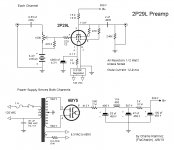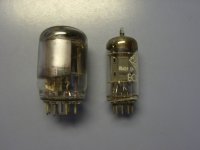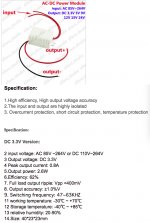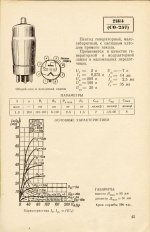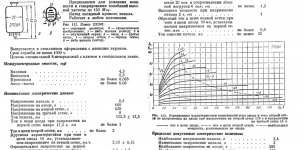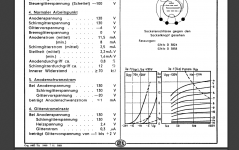So I've been breadboarding some preamp circuits and wanted to try some "battery tubes" so, of course, the 2P29L caught my eye. Rather than posting to the 4P1L megathread I thought I'd start a new one.
I'm pretty much a copy and paste builder, not a designer, and my technical knowledge is limited, unlike many of the posters here.
I build low cost, "bang for the buck" stuff. So no expensive plate chokes, vibrator loads, output transformers or trick Rod Coleman filament supplies. Just keepin' it simple using a very basic circuit with parts I had on hand. It's a budget build not a state-of-the-art design.
I used a lower voltage PT at first, which worked OK but I remembered the rule of thumb that says a plate load resistor should be 3 or more times the plate resistance. So that meant using a 15k resistor. To accomplish this I needed more supply voltage so I changed the PT.
The current PS is built around a NOS Halldorson PT I picked up years ago at an estate sale. Because the voltages were getting a bit closer to the 450v rating of the caps than I like, I added a 500 ohm resistor between the rectifier and the first cap. It's definitely not optimal but it's good enough for a breadboard.
The 6BY5 is a dual damper diode which I chose mainly for its soft start characteristic and because I have a bunch. Plus I already had one set up on the breadboard. A different rectifier with more voltage drop might be a better choice and would, perhaps, allow me to ditch the 500 ohm resistor.
Four AAs supply -6.4v of bias to the grid.
Before switching to the 2P29L, I was experimenting with the 1LE3 and using a single AA on the filament. That tube only draws 50mA so the battery lasted a good long while - roughly 24 hours.
Since the filament current is 150% higher for the 2P29L I decided to try a cheap ($3.55) AC-DC regulated switch mode supply. The output is 3.3 vdc and I'm using a 10 ohm resistor to drop it to 2.1v.
From what I've read, I wouldn't be surprised if this filament supply didn't look too good on a scope. I don't have a scope, all I have is my ears.
I started with batteries, then went to battery in one channel and the AC-DC in the other, then both to the AC-DC. I couldn't hear any difference at all. Not saying there isn't any but it wasn't audible to me.
I added a 6800 uF 6.3v cap after the 10 ohm resistor to see if some filtering would be noticeable. I haven't listened to it with the cap much yet. I'll A-B it next week and see if I hear any difference but I figure it can't hurt whether it's audible or not.
I'm not good at describing what I hear but I find it very detailed yet it doesn't exhibit any harshness. And microphonics are not a problem.
I've used the tube in stock form and also with the aluminum shield removed. The nude version looks more familiar - like a small version of a 7868 - but there's essentially no glow at all.
Here's the current schematic. Comments and suggestions welcome, of course.
I'm pretty much a copy and paste builder, not a designer, and my technical knowledge is limited, unlike many of the posters here.
I build low cost, "bang for the buck" stuff. So no expensive plate chokes, vibrator loads, output transformers or trick Rod Coleman filament supplies. Just keepin' it simple using a very basic circuit with parts I had on hand. It's a budget build not a state-of-the-art design.
I used a lower voltage PT at first, which worked OK but I remembered the rule of thumb that says a plate load resistor should be 3 or more times the plate resistance. So that meant using a 15k resistor. To accomplish this I needed more supply voltage so I changed the PT.
The current PS is built around a NOS Halldorson PT I picked up years ago at an estate sale. Because the voltages were getting a bit closer to the 450v rating of the caps than I like, I added a 500 ohm resistor between the rectifier and the first cap. It's definitely not optimal but it's good enough for a breadboard.
The 6BY5 is a dual damper diode which I chose mainly for its soft start characteristic and because I have a bunch. Plus I already had one set up on the breadboard. A different rectifier with more voltage drop might be a better choice and would, perhaps, allow me to ditch the 500 ohm resistor.
Four AAs supply -6.4v of bias to the grid.
Before switching to the 2P29L, I was experimenting with the 1LE3 and using a single AA on the filament. That tube only draws 50mA so the battery lasted a good long while - roughly 24 hours.
Since the filament current is 150% higher for the 2P29L I decided to try a cheap ($3.55) AC-DC regulated switch mode supply. The output is 3.3 vdc and I'm using a 10 ohm resistor to drop it to 2.1v.
From what I've read, I wouldn't be surprised if this filament supply didn't look too good on a scope. I don't have a scope, all I have is my ears.
I started with batteries, then went to battery in one channel and the AC-DC in the other, then both to the AC-DC. I couldn't hear any difference at all. Not saying there isn't any but it wasn't audible to me.
I added a 6800 uF 6.3v cap after the 10 ohm resistor to see if some filtering would be noticeable. I haven't listened to it with the cap much yet. I'll A-B it next week and see if I hear any difference but I figure it can't hurt whether it's audible or not.
I'm not good at describing what I hear but I find it very detailed yet it doesn't exhibit any harshness. And microphonics are not a problem.
I've used the tube in stock form and also with the aluminum shield removed. The nude version looks more familiar - like a small version of a 7868 - but there's essentially no glow at all.
Here's the current schematic. Comments and suggestions welcome, of course.
Attachments
I'm not sure if anyone has posted this elsewhere but here's what the 2P29L looks like without the shield. Pictured next to a 12AX7 for perspective.
Oooo stubbies!
I have been thinking of trying a battery tube build with some rod pentodes I have stashed away. (1J29B and 1P24B If I recall)
But those 2P29L look more robust for sure!
Oooo stubbies!
I have been thinking of trying a battery tube build with some rod pentodes I have stashed away. (1J29B and 1P24B If I recall)
But those 2P29L look more robust for sure!
Most battery tubes seem to have a reputation for having issues with microphonics.
I'm not sure why but microphonics are not an issue with the 2P29L.
Consider discard the solid state transformer, surely it will generate lots of electrical noise and surely in few time it will explode. They had made with very low quality materials.
Switch mode supplies seem to have both supporters and detractors. I was skeptical but I thought I'd give them a try.
As I said, I don't have a scope so I don't know how much electrical noise they are generating.
I know I did not find any audible difference between them and using a battery on the filaments. Frankly, that surprised me.
I added the 6800 uF 6.3v cap just on principle and left it in even though, once again, I heard no difference. I figure it can't hurt. If noise is being radiated they are so small that they could easily be shielded.
As for their longevity, I guess I'll find out. I'd be more concerned if they were operating near their limits. But since they are rated (maybe legitimately, maybe not) at a maximum of 800 mA and the filament only draws around 122 mA, I'm willing to give them a try. Time will tell.
Most battery tubes seem to have a reputation for having issues with microphonics.
I'm not sure why but microphonics are not an issue with the 2P29L.
This is true, or I have heard as much.
Apparently (So they say) rod pentodes aren't nearly as prone to microphonics. I have yet to find out!
This is a normal pentode powered by rechargeable batteries.
Used in artillery radiostations. Therefore, it has a rigid structure.
IMHO. He doesn't need to be undressed. Aluminum shirt performs the function of electrostatic screen.
Daddy 2P29L is ancient SO257 tube

Used in artillery radiostations. Therefore, it has a rigid structure.
IMHO. He doesn't need to be undressed. Aluminum shirt performs the function of electrostatic screen.
Daddy 2P29L is ancient SO257 tube

Last edited:
Daddy 2P29L is ancient SO257 tube
No. After WW-II German engineers re-designed for Red Army some Telefunken tubes that were designed and manufactured for Wermacht, to use in a mobile equipment. They were re-packaged in Loctal envelopes copied from US tubes. The exception was LS-50 tube that did not fit into an Loctal envelope.
electron Tube Data sheets - Wehrmacht Röhren
You can open both and compare.
Unfortunately, I am very sorry to open them.
But I will definitely clarify this issue.
https://frank.pocnet.net/sheets/043/r/RL2.4P2.pdf is the prototype.
SO-257 that had been later renamed to 2Ж4 was one of most popular pre-WWII tubes, particularly used in РБМ transceivers.
SO-257 that had been later renamed to 2Ж4 was one of most popular pre-WWII tubes, particularly used in РБМ transceivers.
Attachments
Last edited:
Look better, compare shapes of curves on the same voltages and currents, instead of looking at them ignoring different scales on the pictures.
Yes, new tubes were designed to replace old ones in new equipment. Like 6N1P was designed to replace 6N8S and 6N2P was designed to replace 6N9S, but nobody call them "Prototypes". SO-257 were very popular on Russian forum, most probably being advertised by A.M. Likhnitsky, so in order to promote 2P29L some authors compare them to SO-257 instead of original German prototypes that nobody knows.
Once again, German engineers were tasked to repackage German tubes for Soviet army; it would be weird to assume that they were tasked to repackage one Soviet copy of American tubes instead. Later Soviet engineers designed Gu-15 in Gu-50 envelope, but it was a total failure. It was not a German quality...
Yes, new tubes were designed to replace old ones in new equipment. Like 6N1P was designed to replace 6N8S and 6N2P was designed to replace 6N9S, but nobody call them "Prototypes". SO-257 were very popular on Russian forum, most probably being advertised by A.M. Likhnitsky, so in order to promote 2P29L some authors compare them to SO-257 instead of original German prototypes that nobody knows.
Once again, German engineers were tasked to repackage German tubes for Soviet army; it would be weird to assume that they were tasked to repackage one Soviet copy of American tubes instead. Later Soviet engineers designed Gu-15 in Gu-50 envelope, but it was a total failure. It was not a German quality...
Last edited:
A big apology to the topicstarter for the flood.
I've translated the graphs to about the same scale. Curves within the deviation of the parameters of two tubes of the same type.

I asked on the Russian forums help pictures of broken tubes. This will definitely resolve our dispute. No pictures yet.
I've translated the graphs to about the same scale. Curves within the deviation of the parameters of two tubes of the same type.

I asked on the Russian forums help pictures of broken tubes. This will definitely resolve our dispute. No pictures yet.
Indeed they aren't! They don't have thin grid wires that can vibrate upon mechanical excitation.Apparently (So they say) rod pentodes aren't nearly as prone to microphonics. I have yet to find out!
...but were copied as well in almost the same package as the original (as GU-50). Copies also were done in the GDR (P-50), Poland, and China (PU-50).No. After WW-II German engineers re-designed for Red Army some Telefunken tubes that were designed and manufactured for Wermacht, to use in a mobile equipment. They were re-packaged in Loctal envelopes copied from US tubes. The exception was LS-50 tube that did not fit into an Loctal envelope.
electron Tube Data sheets - Wehrmacht Röhren
Even TELEFUNKEN copied themselves, but repackaged the tube as FL152.
But I guess you know that
Best regards!
Even TELEFUNKEN copied themselves, but repackaged the tube as FL152.
Repackaged for civil usage in stationary equipment. Original LS-50 would be too expensive for that. But why they did not increase filament power then? Anyway they designed EL152 with different filaments.
But why they did not increase filament power then?
Was there any demand for that? Filament power ist the same as in EL34's, btw.
Best regards!
- Home
- Amplifiers
- Tubes / Valves
- 2P29L Preamp
